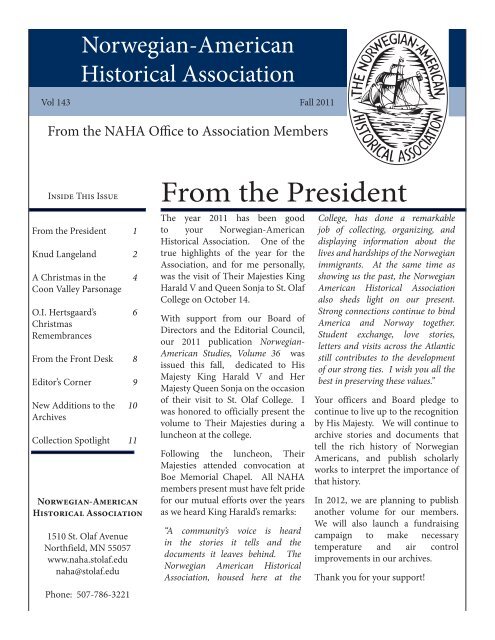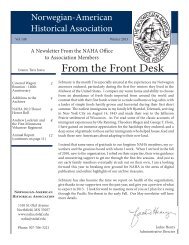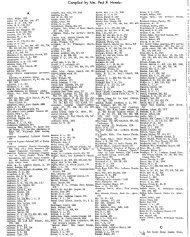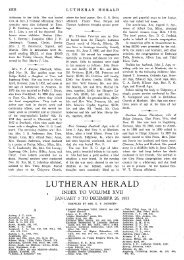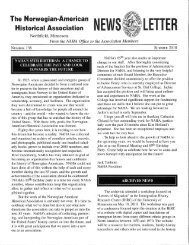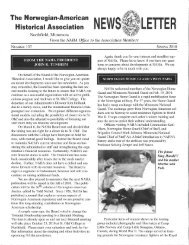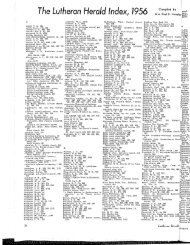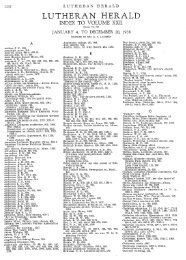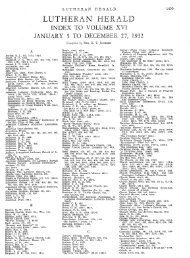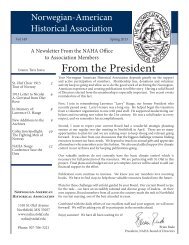Fall 2011 - Norwegian-American Historical Association - St. Olaf ...
Fall 2011 - Norwegian-American Historical Association - St. Olaf ...
Fall 2011 - Norwegian-American Historical Association - St. Olaf ...
You also want an ePaper? Increase the reach of your titles
YUMPU automatically turns print PDFs into web optimized ePapers that Google loves.
<strong>Norwegian</strong>-<strong>American</strong><br />
<strong>Historical</strong> <strong>Association</strong><br />
Vol 143 <strong>Fall</strong> <strong>2011</strong><br />
From the NAHA Office to <strong>Association</strong> Members<br />
Inside This Issue<br />
From the President<br />
Knud Langeland<br />
A Christmas in the<br />
Coon Valley Parsonage<br />
O.I. Hertsgaard’s<br />
Christmas<br />
Remembrances<br />
From the Front Desk<br />
Editor’s Corner<br />
New Additions to the<br />
Archives<br />
Collection Spotlight<br />
<strong>Norwegian</strong>-<strong>American</strong><br />
<strong>Historical</strong> <strong>Association</strong><br />
1510 <strong>St</strong>. <strong>Olaf</strong> Avenue<br />
Northfield, MN 55057<br />
www.naha.stolaf.edu<br />
naha@stolaf.edu<br />
Phone: 507-786-3221<br />
1<br />
2<br />
4<br />
6<br />
8<br />
9<br />
10<br />
11<br />
From the President<br />
The year <strong>2011</strong> has been good<br />
to your <strong>Norwegian</strong>-<strong>American</strong><br />
<strong>Historical</strong> <strong>Association</strong>. One of the<br />
true highlights of the year for the<br />
<strong>Association</strong>, and for me personally,<br />
was the visit of Their Majesties King<br />
Harald V and Queen Sonja to <strong>St</strong>. <strong>Olaf</strong><br />
College on October 14.<br />
With support from our Board of<br />
Directors and the Editorial Council,<br />
our <strong>2011</strong> publication <strong>Norwegian</strong>-<br />
<strong>American</strong> <strong>St</strong>udies, Volume 36 was<br />
issued this fall, dedicated to His<br />
Majesty King Harald V and Her<br />
Majesty Queen Sonja on the occasion<br />
of their visit to <strong>St</strong>. <strong>Olaf</strong> College. I<br />
was honored to officially present the<br />
volume to Their Majesties during a<br />
luncheon at the college.<br />
Following the luncheon, Their<br />
Majesties attended convocation at<br />
Boe Memorial Chapel. All NAHA<br />
members present must have felt pride<br />
for our mutual efforts over the years<br />
as we heard King Harald’s remarks:<br />
“A community’s voice is heard<br />
in the stories it tells and the<br />
documents it leaves behind. The<br />
<strong>Norwegian</strong> <strong>American</strong> <strong>Historical</strong><br />
<strong>Association</strong>, housed here at the<br />
College, has done a remarkable<br />
job of collecting, organizing, and<br />
displaying information about the<br />
lives and hardships of the <strong>Norwegian</strong><br />
immigrants. At the same time as<br />
showing us the past, the <strong>Norwegian</strong><br />
<strong>American</strong> <strong>Historical</strong> <strong>Association</strong><br />
also sheds light on our present.<br />
<strong>St</strong>rong connections continue to bind<br />
America and Norway together.<br />
<strong>St</strong>udent exchange, love stories,<br />
letters and visits across the Atlantic<br />
still contributes to the development<br />
of our strong ties. I wish you all the<br />
best in preserving these values.”<br />
Your officers and Board pledge to<br />
continue to live up to the recognition<br />
by His Majesty. We will continue to<br />
archive stories and documents that<br />
tell the rich history of <strong>Norwegian</strong><br />
<strong>American</strong>s, and publish scholarly<br />
works to interpret the importance of<br />
that history.<br />
In 2012, we are planning to publish<br />
another volume for our members.<br />
We will also launch a fundraising<br />
campaign to make necessary<br />
temperature and air control<br />
improvements in our archives.<br />
Thank you for your support!
Page 2<br />
Knud Langeland, Nordmændene i Amerika/<br />
Photo of the original publication,<br />
Nordmændene i Amerika.<br />
The new publication will replicate<br />
the appearance of the 1888 original<br />
with the addition of the English<br />
translation alongside the original<br />
text.<br />
According to the Chicago<br />
newspaper Skandinaven’s 1888<br />
observation, “Knud Langeland’s life<br />
and activities must be considered<br />
among the most meaningful of<br />
immigrated <strong>Norwegian</strong>s.” He was<br />
born October 27, 1813, in the<br />
municipality of Samnanger east of<br />
the city of Bergen as the youngest of<br />
nine siblings on a small farm where<br />
the main livelihood was raising<br />
cattle. His father died when he was<br />
only thirteen years old and the farm<br />
was sold a few years later and he was<br />
left to “seek his own fortune”; as a<br />
member of the working classes he<br />
suffered the social discrimination<br />
and injustice of his day. His own<br />
experience and his strong faith in<br />
human equality influenced greatly<br />
his social and political activities<br />
throughout his life. Langeland<br />
pursued education through self<br />
study and private instruction and<br />
found employment as a country<br />
itinerant teacher close to his home<br />
community and as sexton in the local<br />
congregation. Before immigrating<br />
to America in 1843, he spent six<br />
months in England learning the<br />
English language, and thus arrived<br />
with skills that greatly eased his<br />
adjustment to the new society.<br />
In America, Langeland settled on a<br />
farm in Racine County, Wisconsin.<br />
He described America as “the Land of<br />
Newspapers,” and he himself gained<br />
great prominence in <strong>Norwegian</strong>-<br />
<strong>American</strong> journalism. In the fall<br />
of 1849 he purchased the pioneer<br />
newspaper Nordlyset, launched in<br />
Muskego in 1847, and moved it to<br />
Racine. The name was later altered<br />
to Democraten and from June 1851<br />
it was published in Inmansville until<br />
it ceased publication in October.<br />
It saw itself as the <strong>Norwegian</strong><br />
standard-bearer of the Democratic<br />
Party in Wisconsin; analogous to<br />
Nordlyset it was strongly antislavery<br />
and advocated the Free Soil policy<br />
of free public lands. Journalism led<br />
to politics, and in 1860 Langeland<br />
served in the Wisconsin legislature.<br />
His editorship of Skandinaven from<br />
its establishment in 1866 nearly<br />
continuously until 1881 gained<br />
him his greatest fame. Skandinaven<br />
became an organ for the ordinary<br />
person and enjoyed a powerful<br />
position among <strong>Norwegian</strong><br />
<strong>American</strong>s, for a time enjoying the<br />
position as the largest <strong>Norwegian</strong>language<br />
newspaper, not only in<br />
America, but in the entire world.<br />
Skandinaven was consistently<br />
Republican, and political candidates<br />
eagerly sought the newspaper’s<br />
support. Langeland urged<br />
Scandinavian unity at the polls to<br />
assure proportionate share of public<br />
offices, accusing the Republican<br />
Party of not doing its duty toward<br />
the Scandinavians, who, as he<br />
wrote, joined the party because it<br />
was founded on the eternal truth<br />
of equality before the law for all<br />
citizens of the land without regard<br />
to religion, place of birth, or color of<br />
skin.<br />
Skandinaven became lowchurch<br />
and sympathetic to the<br />
lay movement; followers of the
Page 3<br />
<strong>Norwegian</strong>s in America by Odd S. Lovoll<br />
<strong>Norwegian</strong> lay Lutheran religious<br />
leader Hans Nielsen Hauge<br />
regarded the newspaper as their<br />
organ. Langeland’s editorial policy<br />
expressed an anticlerical position<br />
toward the high-church <strong>Norwegian</strong><br />
Synod. As the long-time editor of<br />
Decorah-Posten Johannes Wist<br />
writes, “Langeland’s ingrained illwill<br />
toward <strong>Norwegian</strong> authority<br />
figures made him give special<br />
attention to <strong>Norwegian</strong> theologians<br />
in this country, who in his eyes<br />
represented the same mindset as<br />
the government officials in [his<br />
birthplace] Samnanger.” His defense<br />
of the <strong>American</strong> public school<br />
system against the <strong>Norwegian</strong><br />
Synod pastors, who saw it as an<br />
inherent threat to Lutheranism and<br />
the <strong>Norwegian</strong> language, caused a<br />
controversy well documented in the<br />
newspaper’s columns. Langeland<br />
editorially challenged the Synod<br />
clergy; he emphasized that the<br />
common school encouraged<br />
democracy, indirectly taught<br />
religious tolerance, and promoted<br />
patriotism and love of freedom.<br />
His defense of the common school<br />
led to the distinction of having one<br />
of Chicago’s elementary schools<br />
named after him.<br />
Knud Langeland died February 8,<br />
1888, in his home in Milwaukee,<br />
surrounded by his family, his<br />
wife Anna, née Hatlestad, whom<br />
he married in 1849, and their<br />
seven children. That very year his<br />
memories from life in Norway<br />
and in America were published<br />
as Nordmændene i Amerika or<br />
<strong>Norwegian</strong>s in America, stating in<br />
the introduction the following: “It<br />
is not the intention to deliver any<br />
perfect historical work, but on the<br />
other hand to bring the timber and<br />
the rocks that the simple worker<br />
brings to the experienced builder,<br />
so that from this he can erect that<br />
historical building.” Langeland<br />
is here far too modest, as was his<br />
wont in life. It is a work with insight<br />
and reflection, and demonstrates<br />
Langeland’s independence of<br />
thought and interpretation. He<br />
takes the reader on an historical<br />
journey that surely both the<br />
professional keepers of the past and<br />
the interested readers will peruse<br />
with great interest and benefit. The<br />
book is divided into two parts. The<br />
first half treats immigration and the<br />
immigrant experience as Langeland<br />
saw and experienced it; the second<br />
half is autobiographical. In total<br />
Langeland paints a striking social<br />
and political portrait of the time in<br />
which he lived.<br />
A bilingual edition of the book,<br />
retaining the <strong>Norwegian</strong> text<br />
transcribed in Latin letters, and<br />
an English translation, will be<br />
published by Astri My Astri<br />
Publishing in February 2012. Odd-<br />
<strong>St</strong>einar Raneng, a <strong>Norwegian</strong><br />
immigrant to Australia, offers an<br />
excellent translation into English<br />
of nineteenth-century Dano-<br />
<strong>Norwegian</strong>. I am grateful to Deb<br />
Nelson Gourley of Astri My Astri<br />
Publishing for the opportunity to<br />
cooperate in the preparation of<br />
the manuscript and to contribute<br />
a foreword. It was my intention<br />
as NAHA’s editor to make<br />
Langeland’s book in translation a<br />
NAHA publication and worked<br />
together with Clarence A.<br />
Clausen (May 30, 1896 – May<br />
10, 1991) - friend, long-time<br />
professor at <strong>St</strong>. <strong>Olaf</strong> College and<br />
NAHA supporter - to that end.<br />
We were unfortunately not able to<br />
complete the project. <strong>Norwegian</strong>s<br />
in America/Nordmændene i<br />
Amerika will be dedicated to<br />
Clausen’s memory in gratitude for<br />
his support and assistance during<br />
my tenure as the <strong>Association</strong>’s<br />
editor.<br />
How to order the book:<br />
Call - send a check - or order from the<br />
website:<br />
Astri My Astri Publishing<br />
Deb Nelson Gourley<br />
602 3rd Ave SW, Waukon, IA 52172<br />
Phone: 563-568-6229<br />
$24.95 includes FREE shipping in the<br />
USA.<br />
gourleydeb@gmail.com<br />
http://www.astrimyastri.com
Page 4<br />
En Jul i Coon Valley<br />
This is an excerpt<br />
from an article that<br />
first appeared in “Jul i<br />
Vesterheimen” in 1946.<br />
The translation was<br />
provided by Pastor L.A.<br />
Mathre in 1965.<br />
The translation is part<br />
of the John N. Midtlien<br />
collection at the<br />
<strong>Norwegian</strong>-<strong>American</strong><br />
Historial <strong>Association</strong>.<br />
J. N. Midtlien (1877-<br />
1966) was a <strong>Norwegian</strong><br />
born Lutheran<br />
clergyman.<br />
It was Christmas of 1903, forty three<br />
years ago. I was at the time a student<br />
at <strong>St</strong>. <strong>Olaf</strong> College and was home for<br />
Christmas in my dear Coon Valley<br />
community. At the same time Olaus<br />
Sövde was also on a Christmas visit<br />
in the settlement. He was a student<br />
at Luther Theological Seminary in<br />
<strong>St</strong>. Paul. Later he became Pastor<br />
Roalkvam’s successor in Coon<br />
Valley. Both of us were invited to<br />
dinner at the parsonage the day<br />
after Christmas. Moreover, we had<br />
a standing invitation which I made<br />
use of as often as convenient when<br />
I was home. It was brilliant winter<br />
weather, with snow-covered winter<br />
roads, when we arrived at the<br />
parsonage, but as the old proverb<br />
says: “No one knows the day before<br />
the sun goes down.”<br />
It so happened that toward the<br />
evening a blustering snowstorm<br />
broke loose, with the result that we<br />
had to remain over night, for which<br />
we received a hearty invitation from<br />
the pastor’s wife. By remaining<br />
we had an extended opportunity<br />
to participate in the Christmas<br />
celebration in the parsonage. It<br />
is unnecessary to say that in this<br />
house it was not Christmas Eve,<br />
and Christmas Day. Christmas<br />
was Christmas in <strong>Norwegian</strong> style<br />
at Roalkvams’; it stretched over<br />
twelve days; including New Years<br />
and lasting until Epiphany. The<br />
snowstorm had abated towards<br />
the morning of the third day of<br />
Christmas. However, the snow lay<br />
so deep and was so packed that<br />
the roads were entirely impassable.<br />
The pastor should have Christmas<br />
servitudes that day in an outlying<br />
church, but even he who was not<br />
easily frightened by bad weather or<br />
bad roads - had to stay home that<br />
day.<br />
It was always festive in the<br />
parsonage; for the parsonage folks<br />
were of the kind who carried all<br />
trials to themselves and always<br />
showed visitors a friendly and a calm<br />
face. But things were most festive at<br />
Christmas. Then the whole house<br />
was decorated for the holidays.<br />
Then the fragrant aroma of coffee<br />
and all sorts of baking were at their<br />
best in the kitchen, and the dining<br />
room. It seems as though I can<br />
still sense the delightful cardamom<br />
fragrance in my nostrils. And then,<br />
more than otherwise, it was as if the<br />
sweet fragrance of Christ streamed<br />
out from Christian hearts.<br />
There were always lots of folks there<br />
at Christmas time. In addition to<br />
the family itself, visiting relatives<br />
and friends came. Others besides<br />
Olaus Sövde and I had discovered<br />
that at the parsonage it was good<br />
to celebrate Christmas. This<br />
Christmas was no exception. There<br />
were certainly no lack of Christmas<br />
guests.<br />
The assembled group was as follows:<br />
The daughter Anna, who was a<br />
music student at <strong>St</strong>. <strong>Olaf</strong> College<br />
naturally wished to be home for<br />
Christmas. With her had come
Page 5<br />
gamle prestegård by J. N. Midtlien<br />
another <strong>St</strong>. <strong>Olaf</strong> student, Henrik<br />
Tonning, a younger brother of the<br />
Pastor’s wife. Then there were no<br />
less than three of her sisters: Marie,<br />
Tomah and Katy and her three<br />
small boys - Thomas, Einar and<br />
Marcus. Also, the Roalkvams had<br />
an adopted daughter, Dora. The last<br />
was Mrs. Roalkvam’s nephew, who<br />
did the chores. There was a farm in<br />
connection with the parsonage, and<br />
the herd of cattle was not so small.<br />
Yes, indeed, a Christmas mood was<br />
over the entire place - over yard and<br />
stall and barn; but especially within<br />
the house itself. There was the<br />
fragrance of pine needles and there<br />
were Christmas lights in the parlor,<br />
where the Christmas tree stood. On<br />
the library table in the pastor’s study,<br />
next to the living room, lay a stack<br />
of beautifully illustrated Christmas<br />
booklets. Most of these, if not all<br />
of them, were from Norway, for<br />
this was before the publishing<br />
house manager Sundheim, had<br />
sent out the very first number of<br />
“Jul i Vesterheimen”, and almost<br />
a generation before Haugan’s<br />
“Christmas”.<br />
In the big dining room there was an<br />
enormously long Christmas table<br />
constantly set, with many kinds of<br />
Christmas decorations on it. This in<br />
itself gave an incomparable feeling<br />
of Christmas through the holiday<br />
season.<br />
The guests had placed themselves<br />
at the breakfast table the morning<br />
of the third day of Christmas;<br />
but the host had not yet made his<br />
appearance. “O, there he comes<br />
dressed in a warm robe, in from<br />
the study with the devotional book<br />
in his hand.” Roalkvam always<br />
had morning devotions. As always<br />
at the parsonage table, the going<br />
conversation was easy and natural<br />
- not didactic, yet truly instructive.<br />
The guests in the place arose from<br />
the table with a feeling, not only of<br />
being well satisfied with delicious<br />
and nourishing food but with a<br />
definite sense of having received<br />
something for the soul and spirit.<br />
The day passed quickly. All too<br />
quickly, so thought all of us who<br />
were guests. Evening came as a<br />
climax. After supper the pastor sat<br />
down under a cozy reading lamp<br />
and read aloud for us. It was a real<br />
joy to hear Pastor Roalkvam read.<br />
Then Anna went to the piano and<br />
the entire company gathered around<br />
her to sing. Self-evidently it was<br />
mostly Christmas songs that were<br />
sung. The thoroughly cozy evening<br />
closed with the serving of nuts and<br />
cakes. I have never been present at<br />
any entertainment - be it the finest<br />
concert - which I have enjoyed as<br />
much as that evening at Christmastide<br />
in Coon Valley parsonage.<br />
The next morning we two students<br />
were awakened by a light knock at the<br />
door, which was at once opened, and<br />
there he stood, with a large armful<br />
of firewood - the pastor himself!<br />
He wished us a good morning and<br />
a good continuation of Christmas.<br />
In spite of our protest he himself<br />
fired up the stove, and remained<br />
standing a while to talk while the<br />
wood began to crackle and there<br />
was a rumble in the stove pipe.<br />
Quite naturally we lay in bed till<br />
the room became good and warm.<br />
Young people like to stretch a bit<br />
in bed early in the morning.<br />
We were just talking together that<br />
it was high time to get up, when<br />
the door, after a light knock, was<br />
again opened. There, believe it or<br />
not, the pastor stood again - this<br />
time with a large coffee tray neatly<br />
balanced on one hand. “Coffee<br />
in the bed! Now, now Pastor<br />
Roalkvam, this goes beyond all<br />
bounds! You spoil us completely.”<br />
“It is Christmas only once a year” -<br />
He smiled quietly in his whiskers;<br />
“At any rate it doesn’t happen often<br />
that you get coffee in bed in your<br />
student quarters - so you will not<br />
so easily be spoiled this once!” I<br />
tell you, the steaming coffee and<br />
Mrs. Roalkvam’s Christmas bread,<br />
heavily buttered, tasted great.
Page 6<br />
O.I. Hertsgaard’s Christmas<br />
O.I. Hertsgaard used the following<br />
text for a speech given in 1975 to the<br />
101 Club at Bethlehem Lutheran<br />
Church in Minneapolis.<br />
A graduate of <strong>St</strong>. <strong>Olaf</strong> College in<br />
1908, Hertsgaard became a director<br />
of music at Concordia College,<br />
Moorhead, Minnesota, 1909-1913,<br />
after which he embarked on a long<br />
career as a representative for the<br />
Mutual Trust Insurance Company.<br />
He served many terms on the boards<br />
of Fairview Hospital and <strong>St</strong>. <strong>Olaf</strong><br />
College and held executive positions<br />
in a great many organizations. In<br />
1939 he organized a Folk Festival,<br />
one of the events in honor of the<br />
visit of Crown Prince Olav and<br />
Crown Princess Martha of Norway.<br />
Because of his long association<br />
with Hallinglaget and his frequent<br />
visits to Norway, he was popularly<br />
known as “Hallingkongen.” He<br />
was President of Bygdelagenes<br />
Faellesraadet for twelve years, in<br />
which connection he promoted<br />
the publication of “A Folk Epic,<br />
The Bygdelag in America,” 1975.<br />
He received the <strong>St</strong>. Olav Medal in<br />
1940 and the Knight’s Cross, First<br />
Class, of the Royal Order of <strong>St</strong>.<br />
Olav, in 1947, from King Haakon<br />
of Norway.<br />
No doubt the Christmas activities<br />
in the Kindred, North Dakota<br />
community were typical of all other<br />
communities where <strong>Norwegian</strong><br />
immigrants were a majority.<br />
Preparing for Christmas started<br />
about three weeks before Christmas<br />
Day. Butchering “the fatted calf ”<br />
and three or four pigs was the job<br />
of the men folks. The women had<br />
to do all the baking and cooking.<br />
Preparing Christmas hospitality<br />
food assumed great importance,<br />
for the Christmas Season lasted for<br />
13 days had run their course. The<br />
usual fare was lefse, lutefisk and<br />
spare ribs. Liquid refreshments<br />
vary, depending on individual cases.<br />
The “powerful” kind of drink called<br />
“pons” was made by pouring alcohol<br />
in boiling water and adding a bit of<br />
cinnamon for flavor. Home brew<br />
was a common Christmas drink,<br />
made of barley, malt and hops.<br />
During the Christmas Season the<br />
“church people”, as they were called,<br />
might unbend to the extent of taking<br />
a wee bit of a sip of homemade wine<br />
made from the juice of wild grapes<br />
and choke cherries. There was keen<br />
competition among the women, for<br />
each one liked to be known as “the<br />
champion.” Good manners forbade<br />
taking more than one fattigman,<br />
krumkake or sandbakkels, and<br />
when the hostess offered a second<br />
helping it got to be a psychological<br />
battle as to how far to go in saying<br />
“No, thank you”, for there was the<br />
danger that the hostess would then<br />
unburden herself with a retort like,<br />
“Oh, you don’t like my cooking.”<br />
Pure hypocrisy of course and all<br />
knew it.<br />
On the prairies of North Dakota<br />
there were no evergreen trees. We<br />
had made candles on the table to<br />
create a Christmassy spirit. Joining<br />
hands, we would circle around the<br />
table, singing “Glade Jule and her<br />
komme dine arme smaa,” all in<br />
<strong>Norwegian</strong> of course. Father or<br />
mother would read the Christmas<br />
gospel after which the presents<br />
were handed to the children. The<br />
grownups didn’t get anything. The<br />
presents for us children were always<br />
home knitted socks or mittens,<br />
sometimes a small pocket knife.<br />
Happy and thankful, we children<br />
would then say our prayers, coached<br />
and prompted by mother, and then<br />
off to bed upstairs in a cold room,<br />
dreaming about the next day when<br />
we piled into bob sleigh headed for<br />
Christmas Day services in town,<br />
for in the church we knew there<br />
would be a big evergreen tree all<br />
lit with dozens of candles. The fire<br />
hazard involved made it necessary<br />
to have a “chief ” ready with pails of<br />
water to put out a fire should it flare<br />
into a blaze. The “tree program”<br />
was recitations and songs, the<br />
performers being chosen from the<br />
“gifted-talented” children, although<br />
I recall the chosen ones would likely<br />
be a child of the minister or the<br />
banker in town. If there was any<br />
jealousy it would likely be among<br />
fond mothers who knew their own<br />
child should have been chosen.
Page 7<br />
Reminiscences<br />
The young ones had only one<br />
interest, namely to get at the job of<br />
distributing the presents. Just like<br />
present day children enjoy “recess”<br />
more than any other activity of the<br />
school program.<br />
As we enter the church for Christmas<br />
Day services, we behold a solid<br />
phalanx of women, all in long black<br />
dresses reaching over the black<br />
buttoned shoes, all of them seated on<br />
the left side of the center aisle, while<br />
on the right sat all the men folks. Not<br />
a single English word was heard, not<br />
from the minister nor anyone else.<br />
Everything was all Norsk – flavored<br />
in various dialects, mostly Halling,<br />
that being the great majority there.<br />
Soon after the minister had started<br />
his sermon the congregation was<br />
asked to rise and sing the <strong>Norwegian</strong><br />
hymn well known to us as “To us<br />
is born a blessed child.” A small,<br />
hand-pumped reed organ tried,<br />
helplessly and hopelessly to get the<br />
congregation to pick up the tempo<br />
a bit but soon had to fall in line<br />
with the long drawn, draggy kind<br />
of singing the congregation had as<br />
its usual pace. Eight or ten stanzas<br />
were a trying ordeal to sit through.<br />
This is a vivid memory for me for at<br />
the age of twelve, I was asked to play<br />
the organ. My cousin and I, (both<br />
born on the same day) alternated as<br />
organist – organ pumper. This was<br />
the first job I ever had – for pay – the<br />
pay being the munificent amount of<br />
ten dollars per year. But there was<br />
a string tied to it, namely the subtle<br />
suggestion that the $10 should be<br />
used to pay for some additional<br />
lessons – that in spite of the fact I<br />
had already then had a total of 52<br />
lessons at an expense of 50¢ per<br />
lesson.<br />
One important part of Christmas<br />
Day services was the offering. That<br />
was an annual gift to the minister.<br />
We all marched single file around<br />
the alter where we placed our 25¢<br />
or 50¢ coins, the minister standing<br />
alongside the offering plate, to smile<br />
and greet the givers, but to me it<br />
seemed as if his glance would flit<br />
over to see what size of coin each<br />
one gave. There was also another<br />
small plate on a table where we<br />
were to add a widow’s mite to the<br />
“klokker”. He was the man who was<br />
to intone an Amen at prescribed<br />
moments. It would happen that<br />
once in a while the “klokker” did<br />
not quite time his Amens correctly.<br />
This would evince a smile from a<br />
few knowing ones in the church and<br />
a rather serious reprimanding look<br />
from the minister. Among those<br />
who offered there was a non-coin<br />
giver. He was the richest farmer<br />
in the neighborhood. When he<br />
approached the offering plate he<br />
had a one dollar bill that he took by<br />
the end and swung it in a high semicircle<br />
so everyone could see that he<br />
was a paper money giver. We did not<br />
have a choir, nor was there an organ<br />
offertory. Instead, the remnant of<br />
the congregation that was not on<br />
the march to or from the alter was<br />
supposed to keep singing as many<br />
stanzas of the total of 22 listed as the<br />
offering hymn.<br />
At the end of the two-hour long<br />
services, there was always a<br />
sociability session outside of the<br />
church. Groups would huddle; the<br />
men would chat about the weather,<br />
livestock, prices etc. While the<br />
women would review the latest<br />
neighborhood gossip, there being<br />
no telephones for that purpose<br />
those days. At no other time of<br />
the year did sociability take over<br />
like Christmas. It might border on<br />
the hilarious when big and small<br />
groups would set out on what was<br />
called “Julebukk” parties. Both<br />
men and women would dress<br />
up in all sorts of disguises, like a<br />
bunch of buffoons. They would<br />
pile into bobsleds and drive from<br />
one farm to another to do their<br />
stunts of entertaining, dancing<br />
and joking and trying to keep<br />
everyone from guessing “who’s<br />
who”. Some kind of treats were<br />
expected at each place, as a slight<br />
sign of appreciation. In a more<br />
serious and dignified way there<br />
was family-friendly intimacy at<br />
all such gatherings, impossible<br />
to describe. Some of my fondest<br />
memories of my early Christmas<br />
experiences in rural North Dakota<br />
were those events.
Page 8<br />
From the Front Desk by Jackie Henry<br />
In this Issue<br />
In celebration of the holiday season,<br />
I’ve delved into the NAHA Archives<br />
for a pair of Christmas stories from<br />
our collection. Though we have<br />
a number of stories from which to<br />
choose, these two were especially<br />
delightful and I hope you enjoy them<br />
as much as I do. If you are interested<br />
in more stories, you can search<br />
the archives through Leif (http://<br />
www.naha.stolaf.edu/archivesdata/<br />
leif/). Just type in “Christmas” and<br />
you’ll find a number of resources,<br />
including stories and poetry. If you<br />
find something of interest, just send<br />
me an email or letter and I’ll make<br />
arrangements to get a copy to you.<br />
I also want to extend a special thankyou<br />
to Odd Lovoll for sharing his<br />
introduction to Knud Langeland,<br />
author of Nordmændene i Amerika.<br />
The new edition will be a unique<br />
reproduction and translation of<br />
the original 1888 edition with the<br />
translated copy appearing side by<br />
side with the original <strong>Norwegian</strong><br />
copy. Thanks too, to Deb Nelson<br />
Gourley of Astri, My Astri<br />
Publishing for providing the images<br />
that accompany the article<br />
A Look at the Year Ahead<br />
We are already planning our<br />
2012 calendar, with events and<br />
publications for the New Year. In<br />
late fall, we’ll hold our 2012 biennial<br />
members meeting, and a planning<br />
committee has formed to develop<br />
the day’s events. Coinciding with<br />
that event will be the release of our<br />
2012 publication, the first in a series<br />
of three editions of America letters.<br />
In addition, I have several other<br />
potential programs for members in<br />
the works, which we will publicize as<br />
details firm up.<br />
Membership Updates<br />
For the first time in many years,<br />
our membership numbers have<br />
remained stable in 2012. I want<br />
to thank all our members for their<br />
renewals and donations given in<br />
<strong>2011</strong>, and offer a special thanks to<br />
those who encouraged others to join<br />
and/or shared a gift membership<br />
with a loved one. More than two<br />
thirds of our operating budget,<br />
including funds for publications,<br />
comes from memberships and gifts.<br />
We literally could not do what we<br />
do with your financial support, and<br />
we are so grateful to you for your<br />
contributions.
Page 9<br />
The Editor’s Corner by Todd Nichol<br />
Sometimes historians are allowed<br />
to read other people’s letters.<br />
Living correspondents may give<br />
you permission to do so, and if<br />
correspondence has been left<br />
among the effects of a family<br />
without restriction, it is altogether<br />
appropriate to read such letters and<br />
think of them as evidence for the<br />
development of the history of an<br />
individual, a family, a community,<br />
an institution, or group of any<br />
sort. Letters in public archival<br />
collections may be another source<br />
for an historical story in which you<br />
are interested.<br />
A good way to acquaint yourself<br />
with what can be learned from<br />
letters would be to read – or read<br />
again – some of our previous<br />
publications. Here I mention<br />
just a few. The pioneering works<br />
of our first editor, Theodore C.<br />
Blegen, including <strong>Norwegian</strong><br />
Migration to America, 1825-1860<br />
and <strong>Norwegian</strong> Migration to<br />
America: The <strong>American</strong> Transition<br />
are based in considerable part<br />
on letters, many of which Blegen<br />
himself gathered in Norway and<br />
the United <strong>St</strong>ates. A touching and<br />
revealing collection of letters is the<br />
correspondence of Gro Svendsen<br />
published under the title Frontier<br />
Mother. These letters help us<br />
see into the life of young woman<br />
who emigrated from Hallingdal<br />
and settled in the Midwest in the<br />
nineteenth century. <strong>St</strong>ill another<br />
collection of letters brings together<br />
correspondents from various<br />
periods and places. This is Solveig<br />
Zempel’s, In Their Own Words.<br />
Don’t overlook her very good<br />
introduction, which is in part about<br />
how to read letters.<br />
Finally, join me anticipating with<br />
great pleasure the publication of<br />
three volumes of immigrant letters,<br />
scheduled for 2012 to 2016. These<br />
volumes will be based on a critical<br />
edition of immigrant letters that<br />
is now nearly complete in several<br />
volumes published in <strong>Norwegian</strong> in<br />
Norway. Orm Øverland will edit<br />
and publish the English version of<br />
these letters as he has the <strong>Norwegian</strong><br />
edition.<br />
In the meantime, look around at<br />
home and inquire as to what letters<br />
may be floating around in the family<br />
circle. There may be interesting<br />
things waiting to be discovered and<br />
considered.<br />
Note: The publications mentioned<br />
in this article are out of print but<br />
available from the <strong>St</strong>. <strong>Olaf</strong> College<br />
Library or the Library of Congress<br />
through interlibrary loan. Check<br />
with your local library for details.
Page 10<br />
New Additions to the Archives<br />
by Gary DeKrey, Archivist<br />
The Archives continue to benefit<br />
from the generosity of members<br />
and friends who have made<br />
important donations. Although<br />
we aren’t able to acknowledge all<br />
donations here, we do appreciate<br />
every donation, large and small.<br />
We welcome additional donations<br />
of <strong>Norwegian</strong>-<strong>American</strong> letters,<br />
diaries, photographs, family<br />
histories, and community<br />
and congregational materials.<br />
Families can be sure that their<br />
donations will remain open for<br />
family consultation in the NAHA<br />
archives. They can also be certain<br />
that family treasures will not<br />
be discarded in a hasty move<br />
or by future generations who<br />
may have lost touch with their<br />
<strong>Norwegian</strong>-<strong>American</strong> heritage.<br />
If you have old photographs of<br />
<strong>Norwegian</strong>-<strong>American</strong> family<br />
members that you can no longer<br />
identify, why not donate them<br />
NAHA staff, visitors, or members<br />
may eventually be able to shed light<br />
on such mystery photo subjects.<br />
Recent additions to the<br />
manuscripts collection include:<br />
Autograph book belonging<br />
to Gilbert Larson, Augustana<br />
College, Canton, South Dakota,<br />
1894-1899. Includes note by fellow<br />
student, O. E. Rølvaag. Added<br />
to Collection P0482: Augustana<br />
College Papers. Donated by<br />
Joy Peterson, Northfield, MN.<br />
Divers, Dorothy. “Biography of<br />
Ingeborg <strong>St</strong>olee.” (Typescript, 11<br />
pages). Added to Collection P1702:<br />
<strong>St</strong>olee Family Papers. Donated<br />
by Marilyn <strong>St</strong>olee, Edina, MN.<br />
We have also recently received the<br />
following <strong>Norwegian</strong>-<strong>American</strong><br />
family histories, memoirs,<br />
and organizational histories:<br />
Telemark to America Volume<br />
III: Settlements, Biographies,<br />
and Telemark Lore (Telelaget of<br />
America, <strong>2011</strong>). Added to Collection<br />
P0465: Bygdelagene Papers/<br />
Telelaget. Donated by Alice Kirn.<br />
Heimerle, <strong>St</strong>eve. Long Distance<br />
Reflections: Musings on a Few<br />
Grandparents, Aunts, Uncles<br />
& Cousins, 1510-1999 (<strong>2011</strong>).<br />
Added to Collection P0539:<br />
Family Histories and Genealogies.<br />
Surnames: Schjelderup, Tønder,<br />
Darre, Hansen, Hesler, Løchen,<br />
Heinecke, Gullicksen, Brautigam,<br />
and Drews. Donated by author.<br />
The Fox Lake [Rice County] Album,<br />
edited by Kenneth Hokeness (2009).<br />
Added to Collection P0539: Family<br />
Histories and Genealogies. Book<br />
focuses on Astri Engebretsdatter<br />
and son Knut Asleson Knutson.<br />
Includes CD: “Ancestors of<br />
Martin Hokeness, 30 Generations<br />
(850 A.D. to 1951),” typescript.<br />
Donated by Martin Hokeness.<br />
Crone-Aamot, Olav Richard. The<br />
Marvelous <strong>Norwegian</strong> Paperclip.<br />
Added to Collection P0565: Norway<br />
in World War II papers. Chronicles<br />
author’s experiences as a member<br />
of the <strong>Norwegian</strong> Resistance Force<br />
MILORG. Donated by author.<br />
Solomonson, Allan G. Gilma<br />
Solomonson: The <strong>St</strong>ory of an<br />
Iowa Farm Wife; and My <strong>St</strong>udent<br />
Years at Luther College 1956-<br />
1960. Added to Collection<br />
P0539: Family Histories and<br />
Genealogies. Donated by author.<br />
Aurdalskyrkja fra Lund sokn<br />
til Valdres prosti (Aurdal<br />
Menighetsråd, 1987); Kyrkja Ved<br />
Fjorden (Utgitt av Svenes soknerad,<br />
1985); Church Life in North Aurdal<br />
Valdres Valley. Added to Collection<br />
P1136: Boral R. Biorn Papers.<br />
Translation by Boral R. Biorn.<br />
Donated by Marie Biorn Sathrum.<br />
Huseby, N. Dean. Haakinson<br />
Family History. Includes a series<br />
of articles written by donor<br />
(family papers all in electronic<br />
format). Added to Collection<br />
P0539: Family Histories and<br />
Genealogies. Donated by author.
Collection Spotlight:<br />
<strong>Norwegian</strong>s in the Attic<br />
by Jeff Sauve, Assistant Archivist<br />
What’s in your attic In the case<br />
of a Northfield, Minn., residence<br />
the attic contained a collection<br />
of <strong>Norwegian</strong> family letters and<br />
photographs belonging to the<br />
original house owners, Elling and<br />
Anna Trolsen Tollefsrud, as well as<br />
the family papers of their son-inlaw,<br />
Carl Hanson.<br />
Current residence owner, Jonathan<br />
Hill, a retired <strong>St</strong>. <strong>Olaf</strong> College<br />
Professor of English, purchased<br />
the house decades ago from Mrs.<br />
Carl (Beatha) Hanson. Prof. Hill<br />
understood the importance of<br />
preserving the collection and<br />
donated the contents to NAHA in<br />
October 2010.<br />
Records indicate that Elling<br />
Tollefsrud, son of Erik E. and Berit<br />
Tollefsrud, emigrated from Norway<br />
in May, 1867, at the age of 10. He<br />
first lived in Orfordville, Wis., later<br />
settling in Northwood, Iowa. On<br />
March 9, 1889, he married Anna,<br />
who was born in Flaa, Hallingdal,<br />
in 1867 and immigrated to the US<br />
at age 19.<br />
The couple moved to Blooming<br />
Prairie in 1902. In the summer<br />
of 1916 the family moved to<br />
Northfield. Elling died in 1925 and<br />
Anna in 1949. She was survived by<br />
three children Mrs. C. M. Hansen<br />
(Beatha) and Mrs. C. H. Johnson<br />
(Emily) both of San Antonio, Texas;<br />
and Mervin Tollefsrud, Northfield,<br />
and three grandchildren, Erling<br />
and Charles Hansen and Enid Ann<br />
Johnson, all of San Antonio.<br />
The collection itself comprises 35<br />
mostly unidentified tintype and<br />
carte-de-visite photographs taken in<br />
the 1860s and 1870s. One particular<br />
image of note is a rare carte-de-visite<br />
of a famous actress and dancer,<br />
Marie Majilton. She performed with<br />
her brothers, Frank and Charles<br />
(known as the Marie Majilton Trio)<br />
in venues mainly on the East Coast.<br />
For those interested in photography<br />
studios, the following are<br />
represented: John H. Olseon,<br />
Minneapolis; A.W. Adams, Decorah,<br />
Iowa, P.A. Gausemel, Kenyon,<br />
Minn.; and L. Peavey, Faribault,<br />
Minn. Images marked “Northwood,<br />
Iowa” and “Mason City, Iowa” are<br />
also part of the collection.<br />
The manuscripts include the<br />
Emmanuel Hanson family papers,<br />
Fergus <strong>Fall</strong>s, Minn. (1896-1931);<br />
World War I letters of Carl Hanson<br />
(1918); and letters from Carl<br />
Hanson’s niece, Clara Guttormonson<br />
Harmon (1920-1931).<br />
Page 11<br />
The Archives continue<br />
to benefit from the<br />
generosity of members and<br />
friends who have made<br />
important donations.<br />
We welcome additional<br />
donations of <strong>Norwegian</strong>-<br />
<strong>American</strong> letters, diaries,<br />
photographs, family<br />
histories, and community<br />
and congregational<br />
materials.<br />
Marie Mjilton<br />
Carte-de-visite
NON-PROFIT ORG.<br />
U.S. POSTAGE PAID<br />
FARIBAULT, MN<br />
PERMIT NO. 21<br />
<strong>Norwegian</strong>-<strong>American</strong><br />
<strong>Historical</strong> <strong>Association</strong><br />
1510 <strong>St</strong>. <strong>Olaf</strong> Avenue<br />
Northfield, MN 55057<br />
www.naha.stolaf.edu<br />
naha@stolaf.edu<br />
Phone: 507-786-3221<br />
Change Service Requested<br />
Happy Holidays<br />
from the<br />
<strong>Norwegian</strong>-<br />
<strong>American</strong><br />
<strong>Historical</strong><br />
<strong>Association</strong><br />
Photo: Perry Norsk<br />
Evangelical Lutheran<br />
Church.<br />
Mt. Horeb, WI<br />
ca. 1906<br />
Collected congregational<br />
papers.


